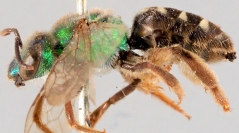

 European Journal of Taxonomy
751 (1) - Pages 1-23
European Journal of Taxonomy
751 (1) - Pages 1-23Many early taxonomic works on North American bees were published by Europeans using specimens collected in the New World, some with type locations so imprecise that uncertainty on the nomenclatural status remains to this day. Two examples come from Fabricius (1745–1808) who described Andrena virescens Fabricius, 1775 and Apis viridula Fabricius, 1793 from “America” and “Boreal America”, respectively. The former species of Agapostemon Guérin-Méneville, 1844 occurs across most of the United States and southern Canada, the latter presumed an endemic to Cuba. The type materials of these two taxa have never been compared to each other, though a morphology-based phylogenetic analysis placed both in distinct species groups. Here we synonymize Apis viridula under Ag. virescens, thereby making Ag. femoralis (Guérin-Méneville, 1844) available as the name for the Cuban species. A lectotype for Ag. femoralis (the type species for the genus Agapostemon) is hereby designated to stabilize this taxonomy. We also synonymize Ag. obscuratus Cresson, 1869 under Ag. femoralis, suggesting that it represents a dark colour polymorphism. As Ag. cubensis Roberts, 1972 is a junior secondary homonym of Ag. cubensis (Spinola, 1851), we offer Ag. robertsi as a replacement name for the former.